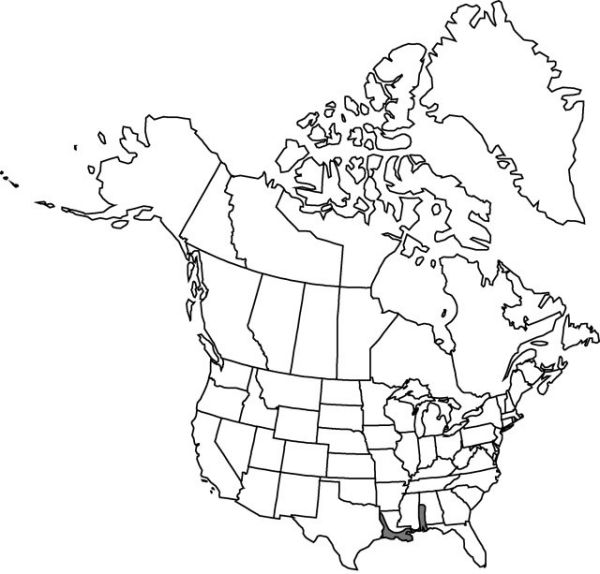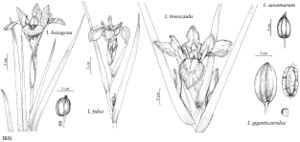Difference between revisions of "Iris giganticaerulea"
Addisonia 14: 5, plate 451. 1929.
FNA>Volume Importer |
imported>Volume Importer |
||
| (6 intermediate revisions by 2 users not shown) | |||
| Line 8: | Line 8: | ||
}} | }} | ||
|common_names=Giant blue iris | |common_names=Giant blue iris | ||
| + | |special_status={{Treatment/ID/Special_status | ||
| + | |code=F | ||
| + | |label=Illustrated | ||
| + | }}{{Treatment/ID/Special_status | ||
| + | |code=E | ||
| + | |label=Endemic | ||
| + | }} | ||
|basionyms= | |basionyms= | ||
|synonyms={{Treatment/ID/Synonym | |synonyms={{Treatment/ID/Synonym | ||
|name=Iris elephantina | |name=Iris elephantina | ||
|authority=Small | |authority=Small | ||
| − | }}{{Treatment/ID/Synonym | + | |rank=species |
| + | }} {{Treatment/ID/Synonym | ||
|name=Iris hexagona var. giganticaerulea | |name=Iris hexagona var. giganticaerulea | ||
|authority=(Small) R. C. Foster | |authority=(Small) R. C. Foster | ||
| − | }}{{Treatment/ID/Synonym | + | |rank=variety |
| + | }} {{Treatment/ID/Synonym | ||
|name=Iris miraculosa | |name=Iris miraculosa | ||
|authority=Small | |authority=Small | ||
| + | |rank=species | ||
}} | }} | ||
|hierarchy=Iridaceae;Iris;Iris subg. Limniris;Iris sect. Limniris;Iris (sect. Limniris) ser. Hexagonae;Iris giganticaerulea | |hierarchy=Iridaceae;Iris;Iris subg. Limniris;Iris sect. Limniris;Iris (sect. Limniris) ser. Hexagonae;Iris giganticaerulea | ||
| Line 40: | Line 50: | ||
-->{{#Taxon: | -->{{#Taxon: | ||
name=Iris giganticaerulea | name=Iris giganticaerulea | ||
| − | |||
|authority=Small | |authority=Small | ||
|rank=species | |rank=species | ||
| Line 53: | Line 62: | ||
|publication title=Addisonia | |publication title=Addisonia | ||
|publication year=1929 | |publication year=1929 | ||
| − | |special status= | + | |special status=Illustrated;Endemic |
| − | |source xml=https:// | + | |source xml=https://bitbucket.org/aafc-mbb/fna-data-curation/src/2e0870ddd59836b60bcf96646a41e87ea5a5943a/coarse_grained_fna_xml/V26/V26_806.xml |
|genus=Iris | |genus=Iris | ||
|subgenus=Iris subg. Limniris | |subgenus=Iris subg. Limniris | ||
Latest revision as of 21:17, 5 November 2020
Rhizomes green, extensively branched, forming large clumps, 2–4 cm diam., with pale leaf scars. Stems 2–3-branched, solid, 10–15(–20+) dm. Leaves: basal 4–6, erect, blade bright green, ensiform, 10–13 dm × 2–3 cm, apex slightly curved; cauline with blade foliaceous, appearing as elongated spathe, 5–6.5 dm × 2–3 cm, not exceeding flowers. Inflorescence units 2–3-flowered, branch units 1–2-flowered; spathes tightly enclosing ovary and pedicel, 15–20 cm, subequal; outer narrowly lanceolate, keeled, margins pale, narrow, inner margins translucent, broad, scarious. Flowers: perianth blue or blue-purple; floral tube tubular-prismatic, 9-ribbed and -grooved, 4–5 cm; sepals blue or blue-purple with white streaks surrounding signal, oval to orbicular-oval, 9.5–11 × 4–5 cm, base abruptly attenuate into claw, apex obtusely angled, signal with raised, yellow, pubescent central ridge, claw green, striate, 4–4.5 × 1–1.2 cm; petals erect or spreading-erect, spatulate, 7–8.5 × 2–3 cm, base cuneate, apex emarginate; ovary bluntly 6-angled, 4–4.5 cm; style blue-violet, keeled, 3.5–4 cm, raised above sepals, crests recurved, 1.5–2 cm, margins sharply and irregularly serrate; stigmas 2-lobed with 2 triangular teeth; pedicel columnar, 3.5–5 cm. Capsules drooping, bright green, ellipsoid, hexagonal in cross section, with 6 broad, rounded lobes, 8–10 × 3 cm, indehiscent; after anthesis, flower stem elongates, arching downward to push capsule into water, where walls are broken down and as funiculus is broken, seed rises to surface. Seeds in 2 rows per locule, brown, D-shaped, 8–10 mm wide, very corky. 2n = 44.
Phenology: Flowering Mar–Apr.
Habitat: Shallow water or very wet roadside ditches
Distribution

Ala., La., Miss.
Discussion
Selected References
None.
